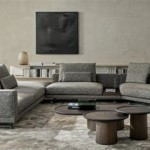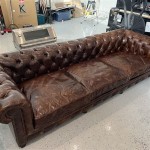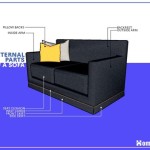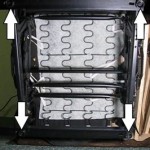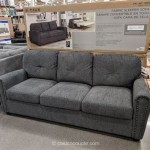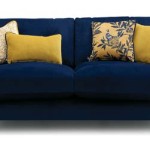Bench Seat Sofa: Pros and Cons
Bench seat sofas offer a sleek, modern aesthetic and a unique seating experience. However, like any furniture choice, they come with advantages and disadvantages. Careful consideration of these factors will help determine if a bench seat sofa is the right fit for a particular space and lifestyle.
Pros of Bench Seat Sofas
Bench seat sofas provide several benefits that contribute to their growing popularity:
- Clean, Modern Aesthetic: The minimalist design of a bench seat sofa lends a contemporary and sophisticated feel to any room. The absence of individual cushions creates a streamlined and uncluttered look.
- Maximum Seating Space: Bench seat sofas offer ample, continuous seating space, accommodating more people comfortably than traditional sofas with separated cushions. This makes them ideal for large gatherings and families.
- Easy to Clean: With fewer crevices and seams than traditional sofas, bench seat sofas are significantly easier to clean. A simple wipe-down or vacuuming is often sufficient to remove dust and debris.
- Versatile Styling: The simplicity of a bench seat sofa makes it adaptable to various decor styles. It can be paired with a variety of throw pillows and blankets to create different looks and add pops of color or texture.
- Ideal for Small Spaces: The streamlined design can make a room appear larger, making bench seat sofas a good option for smaller living areas. Their compact profile can maximize space utilization.
- Can Double as a Daybed: The flat, even surface of a bench seat sofa provides a comfortable space for lounging and can easily double as a guest bed in a pinch.
Cons of Bench Seat Sofas
While bench seat sofas offer several advantages, potential drawbacks should also be considered:
- Lack of Individual Support: The absence of individual cushions can lead to less targeted back and lumbar support compared to traditional sofas. This can be a concern for individuals with back problems or those seeking optimal comfort for extended periods.
- Limited Cushioning: While some bench seat sofas offer substantial padding, the overall cushioning can feel firmer than traditional sofas. This can be a preference issue, and some may find it less comfortable for prolonged sitting.
- Difficult to Replace Cushions: Since the cushion is typically one large piece, replacing it can be more expensive and complex than replacing individual cushions on a standard sofa. Damage to one area necessitates replacing the entire cushion.
- Less Defined Seating Areas: The continuous surface of a bench seat sofa can make it harder to define individual seating areas. This may lead to a feeling of less personal space, especially in larger groups.
- Potential for Sliding: Without individual cushions to grip, there's a potential for sliding, particularly on smoother upholstery materials. This can be especially noticeable for children or pets.
- Can Appear Cold or Formal: The minimalist design, while stylish, can sometimes appear less inviting and cozy than a plush, traditional sofa. This is a subjective perception and depends on individual preferences and overall room decor.
Choosing the Right Bench Seat Sofa
Several factors should be considered when choosing a bench seat sofa:
- Upholstery Material: Consider the durability, comfort, and maintenance requirements of different upholstery options like leather, fabric, or microfiber.
- Frame Construction: A sturdy frame is essential for long-term durability and support. Look for solid wood or reinforced metal frames.
- Cushion Density: Assess the firmness and support offered by the cushion. Consider high-density foam for optimal comfort and longevity.
- Size and Dimensions: Carefully measure the space to ensure the sofa fits comfortably and allows for easy movement around the room.
- Style and Design: Choose a style that complements the existing decor and personal preferences. Consider factors like leg style, armrests, and overall shape.
Placement and Styling
Strategic placement and styling can enhance the visual appeal and functionality of a bench seat sofa:
- Anchor the Space: Use the bench seat sofa as a focal point in the room, arranging other furniture pieces around it.
- Add Throw Pillows and Blankets: Introduce texture, color, and comfort with carefully selected throw pillows and blankets. This can also help define individual seating areas.
- Incorporate Accent Furniture: Complement the sofa with side tables, coffee tables, and other accent pieces to create a cohesive and functional living space.
- Consider Area Rugs: An area rug can help define the seating area and add warmth to the space.
Ultimately, the decision to purchase a bench seat sofa depends on individual needs, preferences, and lifestyle. By carefully weighing the pros and cons and considering the factors outlined above, individuals can make an informed decision and choose a sofa that best suits their living space.

23 Bench Cushion Sofa Favourites And Is Better

What Are The Pros And Cons Of One Cushion Sofas Upgradedhome Com

What S The Big Deal About Bench Seats Buildasofa

Bench Seat Cushions Explained Buildasofa Explainer S

Modern Vs Traditional Bench Seat Sofas

Pros And Cons Of Having Custom Banquette Seating In Your Home

The Best Of Cushions For Your Sofa Plus Good Quality Sofas On Home Glow Design

One Two Or Three Cushion Sofa Which Is Perfect For My Family According To Lilu Interiors Www Liluinteriors Com

The Best Of Cushions For Your Sofa Plus Good Quality Sofas On Home Glow Design
What Are The Pros Cons Of Ottomans Features Benefits Furniture Fair

